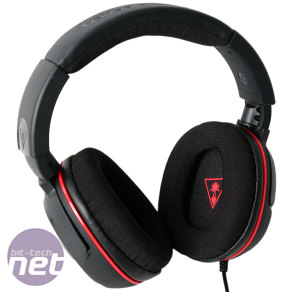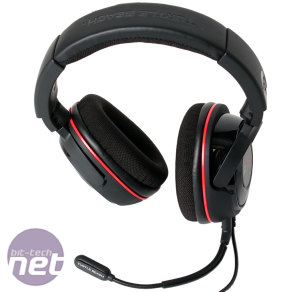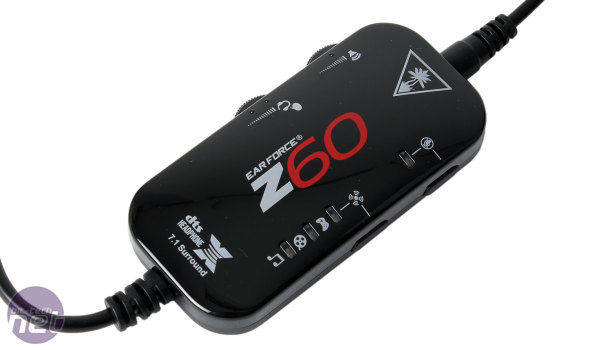
Turtle Beach Ear Force Z60 Review
Manufacturer: Turtle BeachUK price (as reviewed): £85.26 (inc VAT)
US price (as reviewed): $100.53 (ex Tax)
While Turtle Beach dominates the console headset market, its presence amongst PC gamers is much more limited. However, the company is looking to change that, and one of the latest products in its newly expanded range of products that target us mice and keyboard folk is the Ear Force Z60. It's currently not the easiest to find here in the UK, but prices range from £85 to £105 mostly, making it a relatively expensive and high-end product. However, it has a number of features to show for it. It's the first PC headset to use Dolby's new DTS Headphone:X 7.1 surround sound technology and also the first to use 60mm drivers – we thought the 53mm in the Qpad QH-90 and Kingston HyperX Cloud were big. Turtle Beach does note, however, that full compatibility is only guaranteed with PCs, not Macs, where sound quality and signal processing may suffer or not work at all in certain scenarios.
The Ear Force Z60 has an all plastic frame but still maintains good build quality – it feels solid rather than cheap or flimsy. That said, the glossy black plastic on the rear of the closed earcups will be prone to picking up fingerprints and smudges.
The earcups have plenty of pivot and tilt (without feeling too loose) and can be extended a healthy amount too, so it's easy to find a fit. Once you do, you'll find the foam on the headband to be very soft; you hardly notice it at all, especially as the headset is also rather light. Meanwhile, the earcups have some internal leather padding but where they meet your ears is exposed foam, which is firmer than that used on the headband. Overall, it's certainly a comfortable headset, though it's no match here for the ultra soft padding on the HyperX Cloud, and big ears may struggle to fit fully inside the circumaural earcups. Quite a bit of pressure is exerted by the headset, but again it's not uncomfortable, it mostly just helps to contain sound. Were the earcups leather coated things would probably get too hot in sustained use, but as it is the foam lets your ears breathe a little so this isn't an issue.
A detachable, uni-directional microphone is supplied with the Z60, and it clips directly into the left earcup. It has no foam shield on, but is very flexible and easy to move into a position that suits you without it trying to spring back to its original shape.
Also emerging from the left earcup is a non-detachable rubber cable. This ends in a single triple pole 3.5mm jack, which transfers both microphone and stereo sound signals and makes the Z60 compatible with notebooks and mobile phones, though it has no dedicated mobile controls (skip song, answer call, hang up etc.). No adaptor is provided for users with separate stereo and mic jacks either (i.e. the majority of desktop PC users) because the Z60 is really designed to be used with its USB powered amplifier, to which the 3.5mm jack connects. Without this amplifier, the Z60 loses power and its surround sound credentials as it is unable to process sound signals; it simply passes them to the headset like any regular stereo headset.
The amplifier has a built in 44.1kHz, 16-bit sound card that decodes audio signals over its single USB connection. Set-up is as simple as possible, as the Z60 is plug and play, requiring no additional software to run, which isn't always the case with surround sound headsets. The Z60 has two distinct audio channels; one for your general sound and one for communication programs like Skype. Configuration of this should happen automatically, but it's otherwise very easy to do if not.
The glossy plastic in-line remote has no clip but the non-detachable cable from the headset isn't too long so you won't have loads of wiring in the way when reaching for it. Two volume wheels on the left control separately the game and chat audio channels, while two buttons on the right are used to mute the microphone and select the current audio mode. Each wheel and button is easy to reach quickly, though the two wheels are a bit loose and might move if they brush past something. Muting the microphone displays a handy red LED, while the mode selection is indicated by a blue LED next the appropriate symbol (game, movie or music) or no LED at all when in stereo mode, which removes all surround sound effects. The different modes have different suggested uses, and you can see how each performs over the page.

MSI MPG Velox 100R Chassis Review
October 14 2021 | 15:04











Want to comment? Please log in.